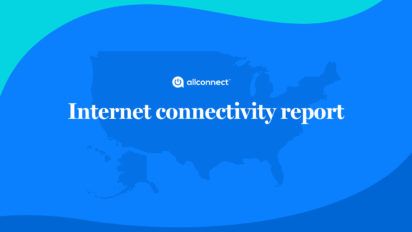With 5G now growing in popularity, many big names in the telecom industry are rushing to be the first to bring newer, more efficient technologies to customers for a good price. But what about fiber internet? After all, it was only a few years ago that providers like AT&T and Google were also racing to build fiber optic networks and deliver the blazing-fast speeds they’re known for.
For those waiting on a fiber internet option, here’s what you can expect from providers and where they plan to break ground next.
AT&T Fiber
AT&T’s fiber network has expanded to cover most of the southern U.S. and parts of the midwest and western regions of the country. According to AT&T, it plans to make fiber internet available to more than 30 million people by 2025.
The company is still on track to succeed in this goal and is in the process of replacing its DSL network with a combination of fixed wireless and fiber.
Is AT&T Fiber available in my area?
AT&T’s comprehensive coverage map can give you a look at every city where AT&T Fiber is available and some areas that’ll be available in the future. Here are a few major metropolitan areas where AT&T Fiber has limited availability so far:
Check out the AT&T Fiber availability map for a look at future serviceable locations coming soon.
See AT&T Fiber internet plansGoogle Fiber
Google Fiber provides some of the fastest fiber connections available but has notoriously had limited availability. That’s quickly changing, though, as the fiber provider is in the process of rolling out its network to new cities across its footprint.
The Google Fiber network is currently available in cities across 19 states. Find Google Fiber serviceable cities below.
Is Google Fiber available in my area?
- Omaha, NE
- Orange County, CA
- Provo, UT
- Salt Lake City, UT
- San Antonio, TX
- San Diego, CA
- San Francisco, CA
- Salt Lake Valley, UT
- Seattle, WA
- Smyrna, TN
- The Triangle, NC
- West Des Moines, IA
Where is Google Fiber expanding?
Google Fiber is coming soon to the following cities:
- Adams County, CO
- Bellevue, NE
- Chandler, AZ
- Council Bluffs, IA
- Golden, CO
- Jefferson City, MO
- Lakewood, CO
- Logan, UT
Verizon Fios
When Verizon rolled out its fiber optic broadband service in 2005, the provider was one of the very first to do so. Now, Verizon Fios is available in nine states across the U.S. and is one of the most reliable fiber-optic internet providers around. Fios has also consistently earned the best scores of any internet provider from the American Customer Satisfaction Index.
In terms of their current outlook, Verizon, like many other providers, will double down on 5G expansion in new and existing markets along with the continuation of fiber build-outs.
Verizon has continued expanding its fiber network by converting existing copper infrastructure. According to the company, it has replaced more than 4.5 million copper circuits with fiber.
The company remains focused expanding its fiber network to 400,000 new locations every year, give or take, with BEAD funding.
Is Verizon Fios available in my area?
Internet service by Verizon is currently primarily available in major metropolitan areas in Northeastern states like New Jersey, Delaware and Rhode Island. Here are a few more cities you’ll find Verizon Fios service:
- Albany, NY
- Baltimore, MD
- Bethesda, MD
- Boston, MA
- Bucks County, PA
- Buffalo, NY
- Columbia, MD
- Delaware Country, PA
- Dover, DE
- Harrisburg, PA
- New Jersey
- New York, NY
- Norfolk, VA
Earthlink
EarthLink is an internet service provider that has served the U.S. for 30 years and has one of the most robust internet networks in the country. The company claims to be able to reach 78% of the country with its internet services.
Is Earthlink available in my area?
EarthLink is available in most major metropolitan areas and some rural areas across the country, though it has a larger presence on the East Coast and Midwest. Here are some cities that have access to EarthLink fiber:
Sonic
Sonic began as a project to connect the campus of Santa Rosa Junior College in Santa Rosa, California back in 1994. It now is a carrier across California, offering fiber internet to residents and businesses. Sonic is well known for its protection of consumer data and commitment to privacy.
Sonic offers a number of fiber plans that provide gigabit speed and better. It offers a traditional fiber connection, as well as a fiber option that utilizes Passive Optical Networking.
Is Sonic available in my area?
Sonic is available in select markets across California. If you are a resident of a major California city or its surrounding metro area, Sonic may be available to you. Here are a few cities that have Sonic fiber internet offerings:
CenturyLink
CenturyLink — now known as Lumen Technologies — offers a fiber internet service known as Quantum Fiber. It started rolling out in 2014 in Omaha, Nebraska and has been rolling out in other markets across the U.S. The company currently reaches nearly 3 million locations with its fiber offerings.
While Lumen’s original fiber deployment utilized the fiber-to-the-node technique, the company has expanded its fiber infrastructure — though it previously sold off some of its copper networks rather than replacing it with new fiber connections.
Is CenturyLink available in my area?
CenturyLink or Lumen Technologies currently offers fiber internet in select markets across the U.S. The company has a significant footprint as an internet service provider when it previously offered DSL connections and may be expanding more in the future. Here are some cities that offer CenturyLink fiber:
See CenturyLink internet plans

Written by:
Camryn Smith
Cammy is a writer with Allconnect, growing her broadband industry knowledge for over a year on the internet marketplace. Her expertise lies in home internet and broadband service with a focus on providers, plans…
Read more
Edited by:
Robin LaytonEditor, Broadband Content
-
Featured
![AT&T Fiber availability 2022 update: Can you get it in your area?]() AT&T Fiber availability 2022 update: Can you get it in your area? Alex Sheehan — 3 min read
AT&T Fiber availability 2022 update: Can you get it in your area? Alex Sheehan — 3 min read -
Featured
![Internet connection types: DSL, Cable, Fiber]() Internet connection types: DSL, Cable, Fiber Lisa Iscrupe — 6 min read
Internet connection types: DSL, Cable, Fiber Lisa Iscrupe — 6 min read -
Featured
![100% of KS and RI residents have broadband access. Where does your state rank?]() 100% of KS and RI residents have broadband access. Where does your state rank? Joe Supan — 5 min read
100% of KS and RI residents have broadband access. Where does your state rank? Joe Supan — 5 min read
Latest
-
Thursday, July 25, 2024
Worried about losing your signal? This is how to keep your satellite dish cleanDavid Anders — 6 min read
-
Tuesday, July 23, 2024
The best free TV and movie streaming services 2024Camryn Smith — 5 min read
-
Tuesday, July 23, 2024
Everything you need to know about internet speedsRobin Layton — 8 min read






